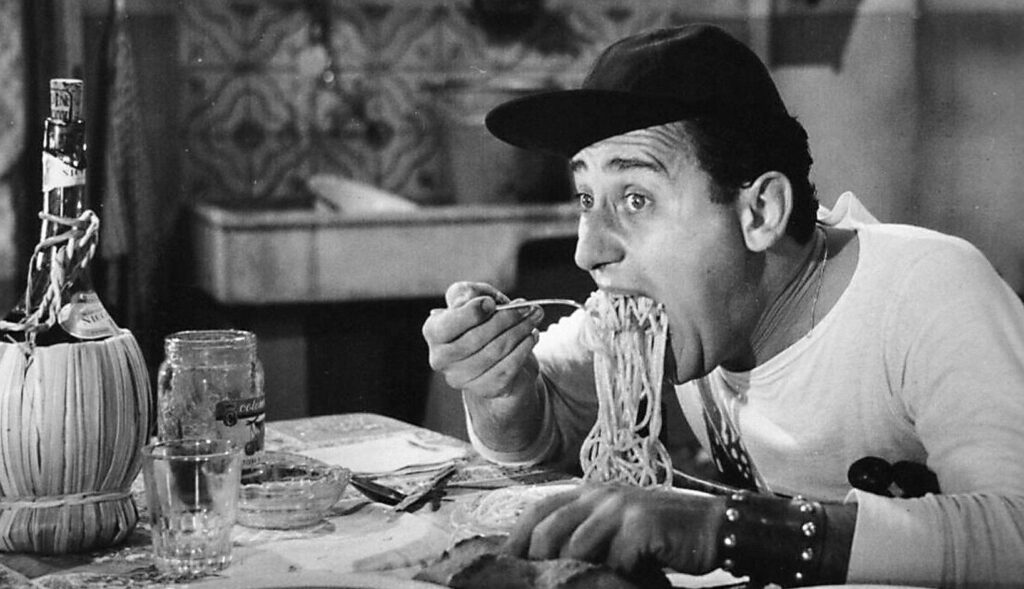Food in Italian Culture – A Delicious and Deep-Rooted Tradition
Italian cuisine is renowned around the world for its delicious flavors, fresh ingredients, and simple yet sophisticated dishes. But food is more than just sustenance in Italy – it is an integral part of the culture and the very fabric of Italian society. From the communal gathering of family and friends around the table to its representation in iconic Italian films, food is a central theme in Italian life. In this article, we’ll explore the rich cultural significance of food in Italian culture, including classic dishes like lasagna, tiramisu, and pizza, and its role in Italian film.
Table of Contents
Italian Culture: The Communal Experience of Sharing a Meal
In Italy, food is more than just sustenance – it is a celebration of life, love, and family. Sharing a meal with others is a central part of Italian culture, and meal times are often extended, leisurely affairs, with the table serving as a gathering place for family and friends. Whether it is a simple lunch of fresh bread, cheese, and cured meats or a more elaborate dinner of pasta, fish, and vegetables, the act of sharing a meal is a time-honored tradition in Italy.
A Celebration of Regional Cultural Diversity in Italian Cuisine
Italy is a country of regions, each with its own unique history, culture, and cuisine. From the hearty stews of Tuscany to the seafood-based dishes of the coastal regions, each area has its own specialties and flavors. This regional diversity is celebrated in Italian cuisine, with local ingredients and cooking methods used to create dishes that are unique to each area. For example, in the southern region of Puglia, dishes like orecchiette pasta and panelle (chickpea fritters) are staple foods, while in the northern region of Lombardy, risotto and polenta are popular dishes.
Iconic Italian Dishes – Lasagna, Tiramisu, and Pizza
Lasagna, tiramisu, and pizza are three of the most famous and beloved dishes in Italian cuisine. Lasagna, a layered dish of pasta, meat, and sauce, is a classic comfort food that has been enjoyed for generations. Tiramisu, a sweet and creamy dessert made with mascarpone cheese and espresso, is a staple of Italian patisseries and cafes. And pizza, of course, needs no introduction. This classic dish of flatbread topped with tomato sauce, cheese, and toppings, has become a staple of modern cuisine around the world.
Italian Food and Wine Culture
Italy is the birthplace of some of the world’s most notable wines. From the sparkling Prosecco of Veneto to the robust Barolo of Piedmont and the vibrant Chianti of Tuscany, the Italian wine culture is as diverse as it is impressive. Each region’s climate and soil conditions contribute to the distinct character of its wines. Vineyards dot the countryside, from the rolling hills of Tuscany to the steep terraces of the Cinque Terre on the Italian Riviera.
Wine is integral to Italian dining and is typically paired thoughtfully with food to complement flavors. The Italians also have a tradition of ‘vino della casa’ or house wine, usually a local wine served in carafes or unlabeled bottles, often at a very reasonable price. Wine tastings and tours are popular activities for visitors in Italy, offering a deeper insight into this essential aspect of Italian culture.
Food and Religion in Italy
Religion plays a significant role in Italian culture and food traditions. The Catholic Church’s influence is particularly noticeable during holidays when specific dishes are prepared and consumed. For example, Christmas in Italy would be incomplete without Panettone, a sweet bread loaf from Milan, or the Pandoro from Verona. Easter calls for a special bread called Colomba, shaped like a dove, symbolizing peace. On Saint Joseph’s Day, Zeppole, a type of Italian pastry, is traditionally prepared. These customs highlight the link between food and religious observances in Italy, adding another layer to the country’s rich gastronomic traditions.
Meal Structure in Italy
Italian meals are a structured affair, often composed of multiple courses. A traditional Italian meal starts with the ‘antipasti’ – a range of appetizers designed to whet the appetite. This is followed by the ‘primo’, a first course typically featuring pasta or rice. The ‘secondo’ is next, generally a meat or fish dish, served alongside a ‘contorno’, or side dish, often a salad or cooked vegetables. To conclude the meal, there is the ‘dolce’, or dessert. Additionally, meals may be complemented with a glass of Italian wine and end with an espresso, never a cappuccino after a meal. This multi-course meal structure emphasizes the Italian love for food and the importance of savoring each dish.
Food and Film – A Delicious Partnership in Italian Culture
Food and film are two of the most prominent elements of Italian culture, and they are often intertwined in Italian films. From the mouth-watering scenes of “Big Night” to the memorable moments of “La Grande Bouffe”, food is used as a symbol of love, life, and community in Italian cinema. In many Italian films, food serves as a backdrop to the action, providing a visual feast for the audience and playing a central role in the story. In “Big Night”, food is used to bring together a community of immigrants who are struggling to preserve their cultural traditions in a new country. The film is a celebration of food, family, and the power of tradition, and it has become a classic of Italian-American cinema. “La Grande Bouffe”, on the other hand, uses food as a symbol of excess and indulgence, with a group of friends embarking on a gluttonous feast that ultimately leads to their downfall. These films, and many others like them, demonstrate the close relationship between food and film in Italian culture and how they are used to explore the deeper themes of life, love, and community.
Italian Cooking Techniques
Italian cuisine is renowned for its simplicity, with many dishes having only four to eight ingredients. Italians rely on the quality of their ingredients rather than elaborate preparation. But despite this simplicity, Italian cooking involves a range of techniques that have been perfected over centuries. Take, for example, the cooking of pasta. It should be cooked ‘al dente’ (to the tooth), meaning it is fully cooked, yet retains a slight bite. The method of preparing a true Italian espresso also involves a precise technique and specific equipment. Whether it’s making the perfect risotto, achieving the right consistency in a ragù sauce, or kneading pizza dough to just the right texture, these techniques contribute to the exceptional quality and flavor of Italian dishes.
In conclusion, food is more than just sustenance in Italian culture – it is a celebration of life, love, and community. From classic dishes like lasagna, tiramisu, and pizza, to its representation in iconic Italian films, food is a central theme in Italian life and a delicious testament to the country’s rich cultural heritage. Whether you are dining in a traditional Italian trattoria, sipping an espresso in a bustling cafe, or watching a film set against the backdrop of a lavish feast, you are experiencing a taste of the heart and soul of Italian culture.
Want to learn more about Italian Food? Join our course on Udemy!


I can see how, from the delectable sequences in “Big Night” to the unforgettable scenes in “La Grande Bouffe,” food is employed in Italian cinema as a symbol of love, life, and community. I was reminded of the last time I ate an Italian meal that I could not even order at a restaurant as I read this story. It’s time for me to make a reservation at an Italian restaurant so that my significant other and I may test it out this weekend. Thanks for the advice.